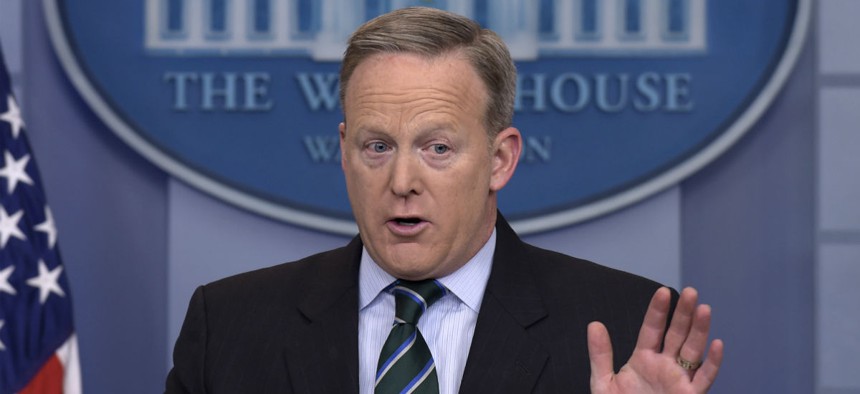
White House Press Secretary Sean Spicer said the freeze is to "make sure we’re hiring smartly and effectively and efficiently.” Susan Walsh/AP
Unanswered Hiring Freeze Questions Leave Agencies Taking Different Approaches
Employees, applicants also expressing uncertainty.
President Trump’s hiring freeze has left employees and agencies alike in a holding pattern, with few details coming from the White House on how it will be implemented.
The moratorium provides potentially broad-reaching exemptions that have yet to be defined, and leaves candidates in the midst of the job application process unclear of where they stand. Trump’s order allows agency leaders to exempt positions they deem “necessary to meet national security or public safety responsibilities.” It also stated the freeze would not revoke any appointment made prior to Jan. 22, 2017.
The details of those policies are still unclear, however. Federal employees have flooded the inboxes of lawmakers’ offices and even Government Executive with questions. Applicants have expressed concern over the current status of conditional offers or whether they should bother starting the process to enter federal service at all. Current employees have asked what jobs would be exempted and whether potential promotions are now defunct.
“So many constituents have called and written to tell stories about how the federal hiring freeze is already hurting them,” said Rep. Don Beyer, a Democrat who represents a fed-heavy area of northern Virginia, in a tweet.
A spokesman for the Office of Management and Budget did not respond to repeated requests for more information, and the Office of Personnel Management and other agencies referred all freeze-related inquiries back to OMB. At his confirmation hearing Tuesday, Mick Mulvaney, Trump’s pick to lead OMB, did not offer any clarity.
“I’m not familiar with the details,” Mulvaney said. If confirmed, he and the yet-to-be-named OPM director will be tasked with developing a long-term federal workforce attrition plan by April 22.
Acting OMB Director Mark Sandy sent guidance -- obtained by Government Executive -- to agency leaders laying out "immediate actions" for implementing the freeze. Sandy said employees with an offer in hand as of Jan. 22 and a start date of Feb. 22 or prior should report to work on the agreed-to date. He directed agency directors to determine whether job offers should stand for those who had an offer as of Jan. 22, but did not have a first day established or it was determined to be after Feb. 22.
"Agency heads should consider merit system principles, essential mission priorities, and current agency resources and funding levels when making determinations about whether or not to revoke appointments," Sandy wrote. He also said, as explained in Trump's order, agency leaders should make "limited exemptions" to the freeze for positions essential to national security or public safety. Sandy added further guidance from OMB and/or OPM, including on the exemptions issue, is still forthcoming.
For now, agencies are taking their own approaches. The Housing and Urban Development Department is continuing to hire normally until it receives further guidance from OMB or OPM, a supervisor at the field office level told Government Executive. An employee at the Army Corps of Engineers told Government Executive guidance came down Wednesday to stop all hiring across the agency “until further notice.”
Robert Snyder, the Veterans Affairs Department’s acting director, said in a statement VA will continue to hire all frontline caregivers and anyone the department “deems necessary for public safety.” A VA spokeswoman did not respond to further questions on the authority Snyder had to make that decision and whether the White House had signed off on it.
White House Press Secretary Sean Spicer sent different signals Tuesday, saying the freeze would apply to VA. The pause would allow Trump’s VA Secretary-designate David Shulkin to be confirmed and assess the best way to move forward at the “broken” department, Spicer said.
“It’s a freeze,” he said. “Hiring people when you have a system that's not working, and then just going out and hiring additional people doesn't seem to be the most efficient way of solving the problem.”
He added: “What we have to do whether it’s VA or any other agency is make sure we’re hiring smartly and effectively and efficiently.”
To some observers, the confusion over the hiring freeze does not come as a surprise. According to one former federal employee who worked with Trump’s transition team, “There was less of a desire to understand OPM and more of a desire to measure the drapes.” Trump’s team demonstrated a “lack of engagement,” the former employee said, adding they hadn’t “thought out” the impacts of the freeze.
Other questions, such as the fate of Trump’s campaign promise to triple the size of Immigration and Customs Enforcement by hiring 10,000 new employees, remain unanswered. Just last week, Steve Mnuchin, secretary-designate of the Treasury Department, said he would like to oversee a hiring surge at the Internal Revenue Service to combat recent attrition. The hiring could take place after the OPM and OMB attrition plan goes into effect -- when the freeze is set to expire -- though the goal of those efforts will be, of course, to cut the size of the federal workforce.
This story has been updated with details from new guidance from the acting OMB director.
NEXT STORY: The Ten Behaviors of Strong Personal Leadership







